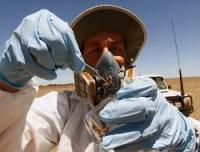A leading expert on the ecotoxicology of pesticides, Pierre Mineau carries out research for Canada’s federal department of the environment at the National Wildlife Research Centre, in Ottawa. He is also Adjunct Research Professor in the department of Biology of the Carleton University. We wanted to know his scientific point of view on Bti use.
email: [email protected]
You are a specialist on the ecotoxicology of pesticides, could you explain your research briefly, and tell us about the main animal species concerned by your work ?

have devoted 30 years of my career to studying pesticides. My research focuses on the impacts of pesticides on wildlife, mainly birds, but also on the environment in general. My number one interest has been the direct impacts, such as poisoning, of pesticide chemicals on birds. However, the framework of my research has also led me to notice the conflicts between pesticides and birds, whether the impacts on the species are direct or indirect.
Cases of mortality, population decline, and concerns with respect to the toxicity of the products released into the environment are some examples that I could mention.
Currently, what have you read or heard about pesticide use that strikes you the most ?
There is a decrease in the use of products that have a direct impact, which explains why scientists are increasingly turning to the study of indirect impacts.
As a specialist of the impacts of pesticides on the environment, have you already seen other studies of the impact of Bti on non-target fauna, similar to the one conducted by the researchers at the Tour du Valat ?
To my knowledge, the only really concrete example concerning an indirect impact through the food chain is a study conducted in the United Kingdom on the Grey partridge. However, in that study there may have been a direct impact, because all insect species were affected. It was therefore easier to find an impact on the feeding of the young Grey partridges.
Meanwhile, as far as studies on Bti are concerned, only some very basic, superficial, short-term research has been conducted, and the results are not very conclusive.
Do you think that the Tour du Valat article provides new information to the scientific community, in particular on the impact on birds?
I am astonished by the TdV Bti impact study, especially the fact that Bti has so many repercussions although it is an extremely well-targeted product. In my opinion, two things are really remarkable: the indirect effect on invertebrates, particularly spiders, and the clarity of the relationships revealed. When I examined the relationships between the availability of prey and the number of birds captured, I was very envious. At the same time, I was disappointed to discover that bioinsecticides could have such a negative impact, because I had been recommending their use for several years.
The impacts demonstrated through this study on Bti underline even more clearly the virulent impact of the chemical products used for mosquito eradication.
In your opinion, is the scope of these results comparable to what is reported in the literature on the effect of pesticides (even chemical ones) on birds?
The unique feature of this study is above all the fact that, on the one hand, there is an impact on insects with direct repercussions on the house martins; and, on the other hand, that the directly affected insects make up 35% of their diet.
When compared to chemical insecticides, the impact of Bti, which had never previously been observed, is very high and by no means insignificant.
The Tour du Valat recommends other solutions for decreasing the annoyance caused by mosquitoes in the Camargue, in particular mosquito traps. Are you familiar with any examples of people who use these CO2 traps or networks of traps to prevent mosquitoes from invading inhabited areas?
No. Mosquito control methods generally target larvae in their natural habitat. However, it is certainly a method that would be interesting to test out.